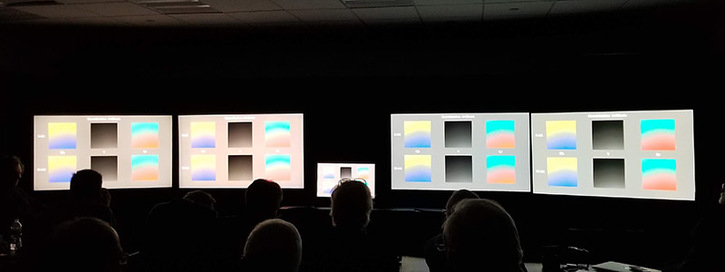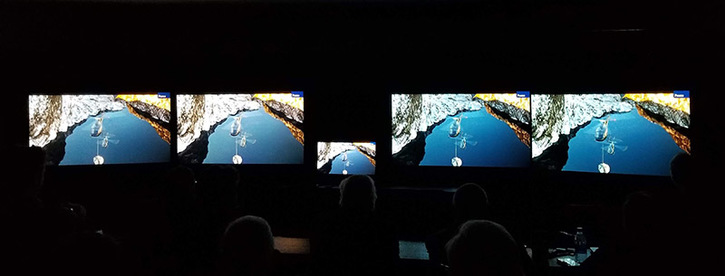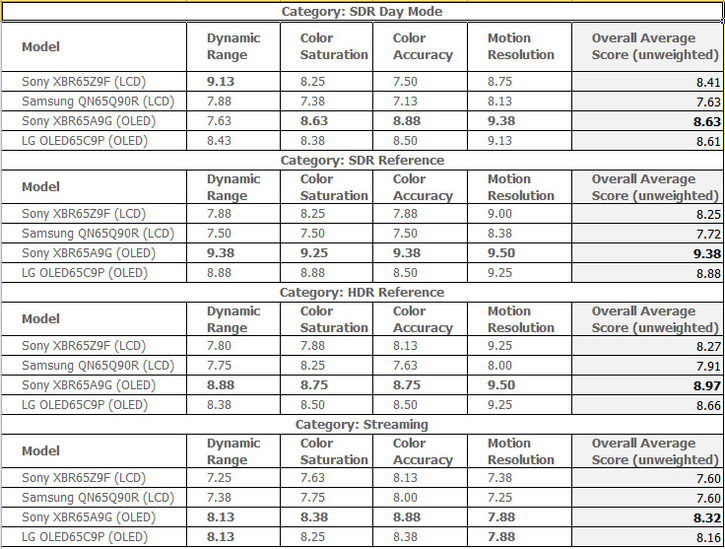Can it be 15 years since the first TV shootout? Apparently it can. Last week at the CE Week show in New York City, Robert Zohn of Value Electronics hosted the fifteenth annual TV shootout. Zohn created the event in 2004 as a way of identifying the TV with the best overall picture quality in each year's new batch. As in previous years, the top performing TVs were put side by side to determine which set takes the prize as the current King of TV.
We've been covering the TV Shootout event since 2011 and it continues to be a great opportunity to see the best of the best of the latest TVs all in one room.
Up for consideration this year were four "4K" Ultra HD TVs: two LED/LCD TVs and two OLED TVs. Samsung was represented by their flagship "QLED" TV (an LED-lit LCD TV with Quantum Dot color technology) the QN65Q90R ($3,499). Sony had two entrants, the XBR65Z9F LED/LCD TV ($2,999) and the XBR65A9G OLED ($3,799). LG was represented by the OLED65C9P OLED UHD TV ($3,499). All prices are current MSRP and are subject to change.
Each TV screen measured in at 65 inches diagonally. The TVs were slightly angled toward the main viewing area to minimize any off-axis viewing degradation and each TV was painstakingly calibrated by expert calibrators Kevin Miller and John Reformato to ensure peak performance. ISF founder Joel Silver was also on hand overseeing calibration and providing the judging criteria.

As a reference, the 30-inch Sony BVM-X300 4K OLED monitor (a pro display that uses RGB OLED technology) was also on hand. Though it's no longer available for sale, the $30K+ Sony monitor is considered the reference standard for picture performance and accuracy. Judges were instructed to use the Sony BVM as a reference for color and detail. Test materials included numerous 4K test patterns as well as real world content in both 1080p and Ultra HD 4K formats.
While Panasonic's highly rated DP-UB9000 Ultra HD Blu-ray Player was used for some content, many of the movie clips were played back from a Kaleidescape 4K media server which meets or even exceeds the quality of physical Blu-ray and Ultra HD Blu-Ray discs. Streaming sources were also included in order to see how the various sets handle OTT content from the popular streaming media platforms.
While LCD-based TVs have competed since the very earliest TV shootouts, they rarely feature highly in the overall results. Early LCD TVs were plagued by the inability to reproduce deep blacks or richly saturated colors. Also, LCD-based sets can have issues reproducing natural-looking motion, without motion smear or trails. The main cuplrit behind LCD TV's picture problems is the technology's requirement for a backlight. While a CRT, plasma or OLED TV has self-illuminating pixels, LCD panels require that a light be shone through the panel in order to create a viewable image. The main artifact with this approach is a certain amount of light "bleed" around the edges of the pixels which prevents the TV from creating a truly deep black level. This can be mitigated through the use of local dimming technology as well as the equivalent of a window tint on the screen, but it's difficult for LCD TV makers to completely eliminate this flaw.
In the early days of the shootout, the competition was dominated by plasma models from Pioneer, Samsung and Panasonic. Over time as plasma technology was abandoned, OLED (Organic Light Emitting Diode) TVs have risen to the top of the ranks. With the ability to instantly turn on or off each individual pixel, OLED TVs remain unmatched in black level performance. But there are other elements that make up a high quality image, and these are also considered in the TV shootout.
This year, the panel of judges included professional colorists, video scientists and well respected TV reviewers. Judges were asked to evaluate four picture quality elements in four different categories. Picture performance attributes included Dynamic Range, Color Accuracy, Color Saturation and Motion Resolution. The four categories where these attributes were considered included SDR (Standard Dynamic Range) Day Mode, SDR Reference Mode, HDR Reference Mode and Streaming. Lights in the viewing room were kept subdued except for the SDR Day mode tests, where the lights were brought up to something approximating your average living room.

When all was said and done, it was an OLED TV that won the day again. The Sony XBR65A9G OLED TV took home the win in 3 of the 4 categories and tied the LG OLED65C9P OLED TV in the fourth. The LG OLED also turned in an excellent performance overall and was only slightly behind the leader. Scores were quite close between the two OLEDs with just a few tenths of a point difference in most cases. Again, no surprise there. It's difficult to match OLED for color saturation and black level reproduction, two of the most important elements in picture performance.
What surprised me was just how far LCD TV technology has come. The Sony XBR65Z9F LED/LCD TV took the top score overall for Dynamic Range in day time viewing mode, and both the Samsung QLED TV and the Sony LED/LCD TV earned scores that were competitive with the OLEDs in several categories. If you are planning to watch TV in mostly bright rooms, either the Sony or Samsung LCD TVs makes an excellent choice.

While shadow detail in darker scenes still tends to be a bit challenging for LCD TVs, both the Sony and Samsung have made noticeable strides here. Some scenes such as bright stars with a deep black background continue to be problematic for LED/LCD TVs as the local dimming processing struggles with this type of content. But even these torture tests have shown improvement year over year. Off-axis viewing, always problematic for LCD TVs has also improved this year with the Samsung most noticeably improved in this category. There is still noticeable dimming of the image off-axis, as well as a shift toward blue, but the off-axis degradation has improved compared to previous years.
Both the Sony and Samsung TVs tested use a full array local dimming backlight. This along with higher peak brightness than the OLED TVs allowed the LED/LCD sets to produce images with impressive dynamic range. But there was some bleed and "blooming" around bright areas of the screen, particularly in areas of sharp contrast such as letterbox bars and those bright stars on a black background.
With Samsung's "MicroLED" technology still only available in ultra expensive professional signage monitors and custom displays, OLED continues to lead the pack for picture technology, at least in consumer displays. But with the strides Samsung and Sony continue to make in picture performance on LCD displays, it will be interesting to see how much closer the results might get in next year's shootout.
Related Links and Articles: